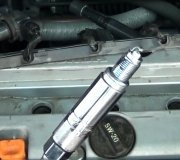I did some research, most common findings with multiple misfires on one bank.
. Cam codes such as these, along with misfire codes on one bank, usually suggest either the timing chain is off by one or more teeth or that bank has incorrect oil flow for the variable cam timing system. In the case of an engine rattle as well, it is likely either the cam phaser is damaged, or there is an oil flow problem to the phaser and tensioner.
2. Before beginning variable cam timing tests, it is important to warn your customer that variable cam timing concerns on this engine can be a very expensive repair. In many cases, the internal passages feeding the phaser or the tensioner will be plugged with debris; getting this debris out can be extremely difficult and sometimes results in the need for a new engine. Informing the customer of this possibility before extensive diagnosis and repair attempts, is recommended.
3. To start diagnosis, run engine at hot idle. When the engine is running poorly, backprobe a ground wire into the variable camshaft solenoids (located at the top of each valve cover) at the following wires, one at a time. Only tap the ground to the wire briefly.
A. Driver's side, Violet and Light Blue wire.
B. Passenger side, Dark Green and Orange wire.
4. If tapping a ground to either solenoid resolves the concern, the solenoid was stuck open either because of debris stuck in the solenoid or because the solenoid itself was stuck.
5. If the concern is still present, unplug both solenoid connectors, if the engine now runs smoothly, suspect circuit faults between the solenoids and the PCM. Note, these solenoids should only be actuated off idle similar to an EGR valve.
6. If the concern is still present with the solenoids unplugged, install a lab scope with at least two channels on the camshaft position sensors (located on the timing cover, one on each side). Install the positive leads at the following wires, install the negative lead to ground.
A. Driver's side, Dark Green wire.
B. Passenger side, Orange wire.
7. Now start the engine; the waveforms should be in exact sync with each other, if one waveform is even slightly out of sync with the other, either the chain has jumped, the sensor is faulty or there is a concern with the phaser assembly. A code P0012 suggests a problem on the passenger side bank, P0022 suggests the problem is on the driver side bank.
8. To rule out a sensor problem, simply swap the sensors bank to bank, if the concern follows the sensor, replace the affected sensor.
9. If the sensor is ok, you will now have to begin determining if this is a phaser concern or a timing chain problem.
10. A phaser that is over-retarded at idle can either be a hydraulic or a mechanical failure. First, swap the solenoids bank to bank, if the concern follows the solenoid, then replace the affected solenoid.
11. If the fault is still present on the same bank, then the timing cover should be removed at this point for removal and inspection of the variable cam timing components.
12. First remove the phaser and inspect for broken trigger, bent trigger, damaged return spring. Replace as necessary. While phaser is removed, inspect the phaser bolt orifice for blockage, clean and replace as necessary.
13. Next remove the solenoid valve body, inspect all orifices for blockage, clean and replace as necessary.
14. If all orifices are ok, reassemble, verify proper chain timing. Restart the engine, if the concern is still present, suspect plugged orifices as discussed in step 2.
Friday, October 4th, 2013 AT 5:35 PM




